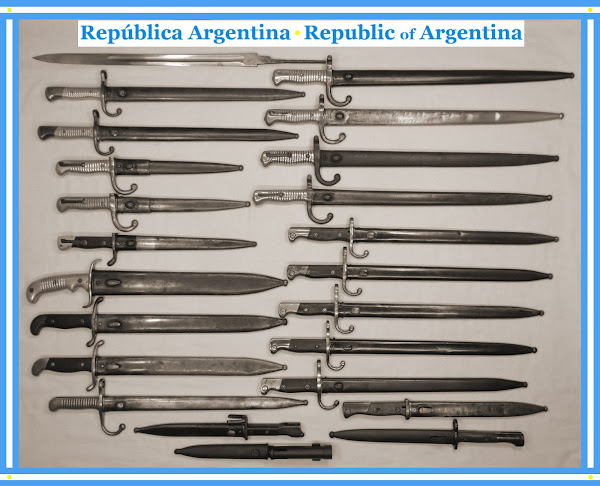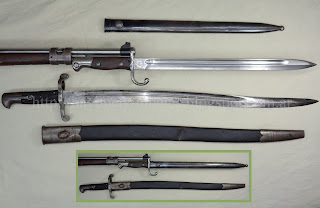ENFIELD PATTERN 1856 "bar on barrel" saber-bayonet (Solingen model for Volunteers)
Origin or destiny: United Kingdom
Respective weapon: it was exclusively designed to fit the ENFIELD PATTERN 1856 "2 band" Short Rifle in .577 caliber and muzzle loading system. Both weapons, bayonet and rifle, were used by British Army Line sergeants and by certain specialized units, as British as from other countries, included in the famous American Civil War where they stood out with their full participation on both sides.
Manufacturer and manufacturing date: it has the HEAD OF THE KING mark, the well known symbol used by several members of the WEYERSBERG family, famous sword smiths (also of sabers and other blade weapons) from the highly considered Solingen of Germany. Its estimated manufacture´s date is between 1856 and 1857 although there were specimens produced in later years (Note: you may have the possibility to acquire a bayonet of this type manufactured in 1858 or later, but you must know the features of its hilt attached way to get a correct identification: if it is a "bar on barrel" or "bar on band" bayonet; in the following points of interest I will perform a detailed description to note the difference between the two types of hilts which they let the right way of attaching to the rifle).
Technical data:
22.79 inches blade length (579 mm)
.43 in blade width (11 mm)
1.22 in blade heigth (31 mm)
5.24 in hilt length, included crossguard (133 mm)
.85 in internal diameter of the muzzle ring (21,5 mm)
28.11 in overall length, included scabbard (714 mm)
Identification Marks: right side on the blade ricasso shows the Head of the King which it was the exclusive mark from its manufacturer WEYERSBERG; and on the same side on the middle of the crossguard there are a stamped British Crown and below a supposed letter G. The last mark is the number 83 placed at the back on the pommel and it possibly refers to the ancient 83rd REGIMENT OF FOOT originated in Dublin, Ireland.
Features and some Observations: yataghan type blade of carbon steel, fullered on both sides, with a spear point, single edge and just a smooth false edge of 190 mm approximately. The steel crossguard has a large muzzle ring with a "cock's comb" at its top, and a straight quillion with "button finial" at its lower place. The hilt is made up by a full tang, which it gradually grows thinner until reaches the join with the steel pommel (*), and it also shows the black pressed-leather grip scales adjusted by four rivets on its left side and by three others on the right (**), moreover a screw tightens the steel spring which it has the block with the inner nail that allows the bayonet is attached to the rifle muzzle pressing the button located on its left side. The T slot is chamfered (like the Chassepot style) to fit the stud of the barrel located on the right side (***). The black leather scabbard presents steel mounts forming the mouth piece with its oval frog stud and the chape with a truncated cone style tip, both of them having the neccesary staples at their back faces. Noteworthy: the curved shape of the scabbard that was designed for a suitable housing of the yataghan blade, the backed sewing of its leather, and the lack of internal throat springs that usually hold the blade into the scabbard preventing undesirable movements.
Comments: Saber-Bayonet with superb design and construction, and a notoriously weightier blade than other "Yataghans" from my collection (according to several written sources, the blades manufactured in United Kingdom were barely lighter than those provided by Germany). Performing my own saber-bayonets fencing style with this beauty I had some opportunities to test "that" weighty blade and I felt myself very comfortable with it, but I had no more chances to continue with the proofs because its left grip scale is very damaged. Two negative and evident points: 1_ the left grip scale that before I mentioned that is in bad state, being understandable because in past era its handle leather was underwent climatic and humidity changes in addition to the destructive effects produced by the acidity of the hands perspiration from its far owner (situating this bayonet in trainings and combats, it was rarely given the necessary care for the hilt area because the blade ever was the most importat thing to give a suitable maintenance); and 2_ the scabbard which was made in a weak leather and I would have preferred a metallic one, obtaining more resistance against climatic changes and serving as a weapon for a counterattack against one or several adversaries in case of loss, breakage or another inconvenece with the bayonet or its blade. Putting aside those undesireable details I must mention the soft stains that they do not offer any oxidation or damage signals on the polished steel blade; in fact, they give a "cool vintage look" to the whole structure and accentuating on it the patina placed on all the other metal parts of this bayonet. Something more to comment: I decided to buy this bayonet knowing the state that I mentioned (its seller had emphasized about it in his web publication where this piece was uploaded showing some photos of its state and he again remembered me at the time of the purchase) but I did not mind about the damage, because for me it was a nice possibility of having a very representative bayonet of an ancient era, and also to know a little about the material used for the grip scales which it was bovine leather; even it is appreciated the tiny hair into the internal rectangular strips used for give form to the structure of such covers. Undoubtedly for me, it was one of my best acquisitions because an opportunity like this was not going to happen again.
Clarification I: there are several points which I have marked with asterisks to enable their reading and understanding.
(*) The tang shows several different thicknesses: the area closed to the crossguard shows .27 inches (7 mm) from above and .18 in (4.5 mm) from below, and it is go becoming thinner through all the way until to reach the join with the pommel, showing other measures as .16 in (4 mm) from above and .10 in (2.5 mm) from below.
(**) Unfortunately the cover of the left grip scale has got almost 35% in its appearance, showing the inner physiognomy constituted by its leather strips though they admirably still keep themselves fixed to the tang. It was regrettable that the half of that cover had several cracks on the rivets areas and they tended to leave off their places, the only way that I could find to joint them again was gluing the cracked parts with vinyl glue, and although it was not the right procedure at least I can fix that fragile area for undetermined time.
(***) The upper hilt area shows both, the tang and the borders of the grip scales with a slight concave shape getting the appropriate adaptation to the barrel curvature at the moment that the bayonet is fixed, and this feature together with its muzzle ring that is born flush with the tang and the chamfered T slot from its pommel, allow that the rifle/musket barrel is aligned without difficulty. These profits have given to this saber-bayonet the added term "bar on barrel" since that it was exclusively designed for that fixing style: the bayonet stud welded to the right side of the firearm barrel and very closed to its muzzle. It should not be confused with the other system used by the Pattern 1858 saber-bayonet called "bar on band", which the ring is NOT born flush with the tang but it rises over a few millimeters more compared to the P-1856, adding that its hilt upper back is flat and straight, and the pommel has no chamfered edges on its T slot.
Clarification II: Two versions of saber-bayonets were designed for the two types of short rifles knew under different names:
1_ Enfield Pattern 1856 "bar on barrel" Short Rifle, also known as Pattern 1856 Nº 1, Pattern 1856 Army Short Rifle, P-1856 Type I or simply P-1856. For this type of rifle, the bayonet was exclusively designed to be fixed to the stud/bar soldered on the barrel.
2_ Enfield Pattern 1858 "bar on band" Short Rifle, sometimes known as Pattern 1856 Nº 2, P1858 Short Rifle, other times as P-1856 Type II or P-1858. And for this type of rifle, the bayonet was obviously designed to be fixed to the stud/bar placed on the first band more closed to the muzzle of barrel.
Note: these two types of rifles had two bands that adjusted the barrel and the stock, and usually they can be found made of iron (destined for Army) or brass (for Navy).
Clarification III: I had before mentioned that the number 83 located on the bayonet pommel may have been the one corresponding to the 83rd REGIMENT OF FOOT from Dublin, and I based myself this assumption because this model of bayonets from Solingen (Germany) were only acquired by Volunteer Units, and in the case of this Regiment there are some informations demonstrating that this kind of saber-bayonets were part of these Units that served to the Britannic Majesty. Many of you will ask for an adecuate explanation about these militias, for that reason I have transcribed the definition that I found in the excellent website called Old-Smithy (the page is Bayonets Terms, and I am going to add the link if you need more data): "Volunteer units were a form of militia unit, and not part of the standing army, these were common in the UK before WWI. Often they were equipped with the same arms as the standing army but weapons were bought privately and do not have military acceptance marks and may have slight differences (brass instead of steel scabbard mounts for example)". Moreover, in other page of this same website (The Yataghan Style bayonet) you can access to more details about the bayonets used by these militia units: "Various volunteer bayonets were made based on the 1856 style blade. These can be found with steel or brass pommels and cross guards. Bayonets are often unmarked or have German Solingen/WKC makers marks, and with heavier blades than the normal military issue blades".
And here I have added some points to have in mind which you may find on Volunteer Bayonets:
· crossguard, pommel, or leather scabbard mounts manufactured in brass
· heavier blades than the standard ones
· slighty short hilts
· grip scales made in wood or bakelite, and with no cleaning holes
· pommel slots for fixing may be shorter, modified or without any slots
Value: 4,5 score points over 5.
Links:
http://www.solo-bayonetas.com/2012/10/reino-unido-united-kingdom_14.html (this is my other blog with the spanish data!)
http://www.svartkrutt.net/articles/vis.php?id=2
https://en.wikipedia.org/wiki/83rd_(County_of_Dublin)_Regiment_of_Foot
http://www.old-smithy.info/bayonets/HTNL%20DOCUMNETS/Bayonet%20Terms.html
http://www.old-smithy.info/bayonets/HTNL%20DOCUMNETS/yataghan%20models.htm
You Tube:
Images
Víctor H. Carrizo




















































.jpg)










